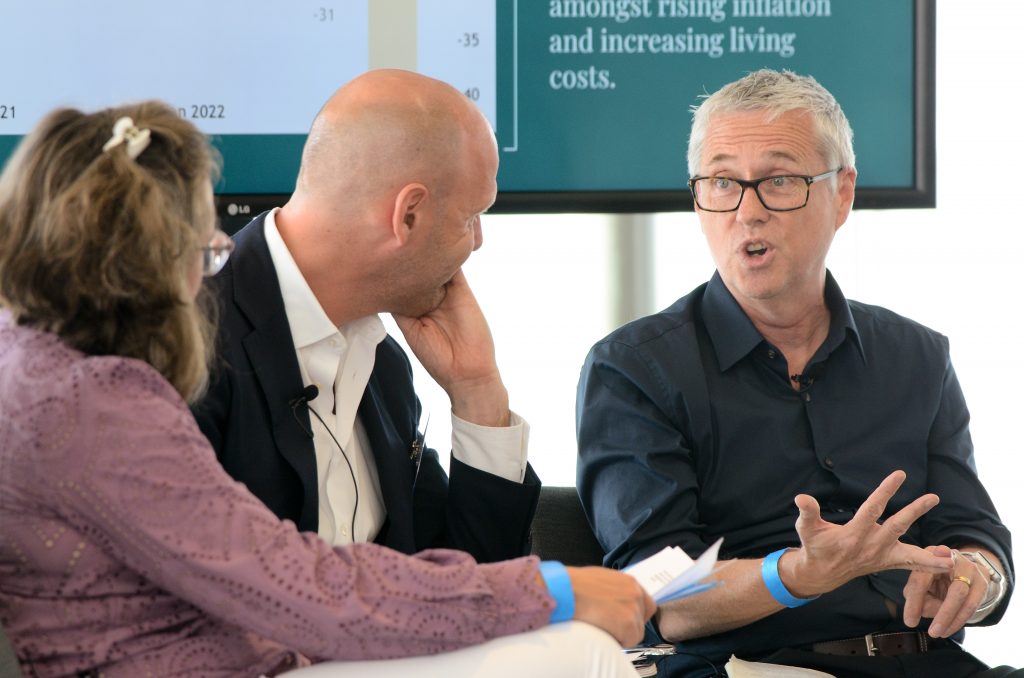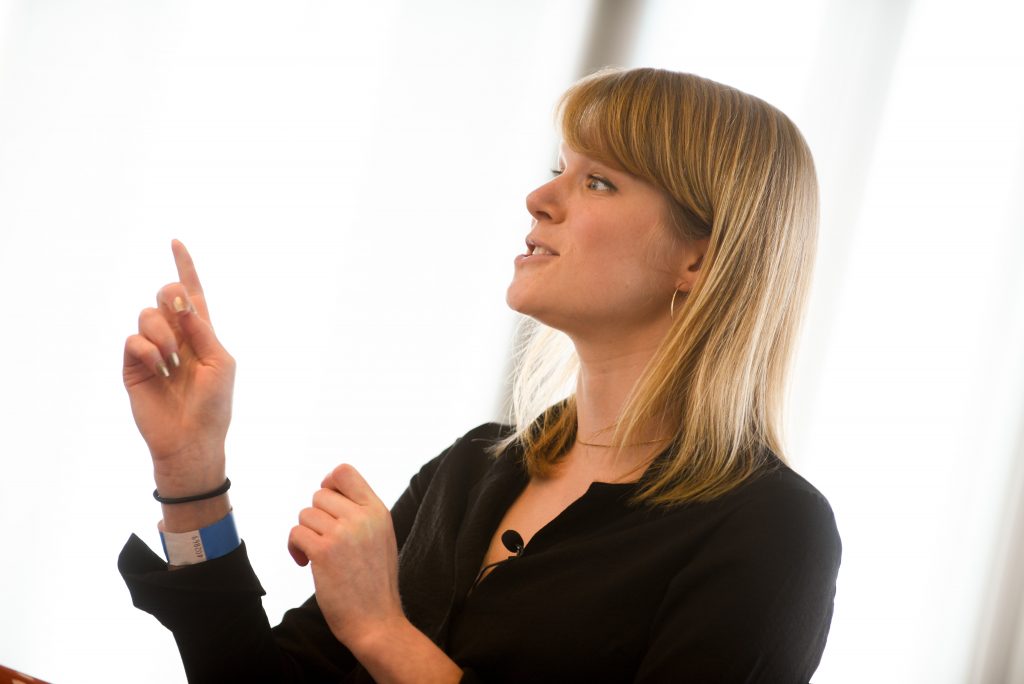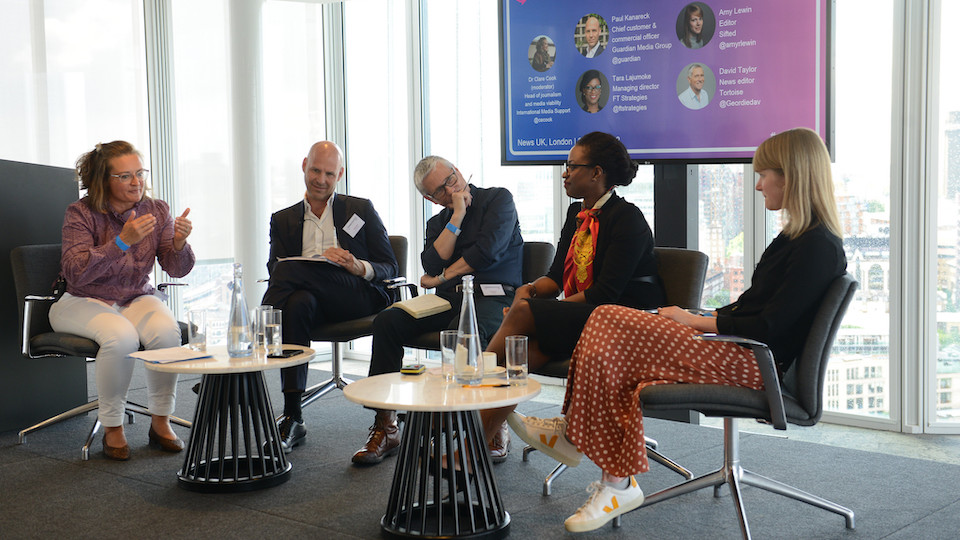By Aruni Sunil
The 30th edition of Journalism.co.uk’s media innovation conference Newsrewired featured a panel with industry experts who discussed their own revenue models and strategies, the challenges and opportunities they are contending with and which audience groups and products they are betting on for growth.
Moderated by Dr. Clare Cook, the head of journalism and media viability at International Media Support, the panel featured Paul Kanareck, chief customer and commercial officer at Guardian Media Group; Tara Lajumoke, managing director at FT Strategies; Amy Lewin, editor at Sifted; and David Taylor, news editor at Tortoise.
The FT has reached its one million subscriber goal a year early; the Guardian and Tortoise are in the Press Gazette’s list of the top ten newsrooms by number of paid members; while Sifted said it launched its own membership one year ago inspired by the startups it reports on.
But even these organisations predict a rocky road ahead, with rising inflation meaning increased costs for the print business and for working with tech platforms at the same time as consumers may be rethinking their subscriptions. According to a 2022 report by Reuters Institute, media companies must “expect subscription fatigue to limit progress, especially if economic conditions worsen”.
Content, pricing or brand?
Cook opened up the debate by asking panelists what exactly was at the heart of succeeding with reader revenue success: content strategy, pricing strategy, or brand-building – or a balance between the three.
Both the Guardian and Tortoise highlight their values of open journalism in their messaging to readers – but Taylor and Kanareck said that great content was still the best way to demonstrate its importance. At Tortoise, editorial ‘hits’, such as the podcast Sweet Bobby which was released in 2021 and reached eight million downloads, are beneficial in increasing reach in new markets and converting new members.

“When we first started we hoped people would join the mission [of slowing down the news]. We are three years old, we’re a startup and we’ve survived. At the start it was ‘come join our mission. As we have grown, it’s ‘come for the stories, stay for the mission’,” explained Taylor.
The Guardian’s Paul Kanareck said: “Our readers understand the relationship we have with them — that what they give us is going into our journalism and hence will be returned to them in the form of quality journalism,” he said.
While keeping the news free for anyone to read is part of the value proposition, it also boosts the organisation’s reach, with 16 billion page impressions in 2021 creating a large marketing funnel.
“The higher the volume of people we have, the greater the chance we have of monetising them,” Kanareck summarised the heart of the strategy. “Our editorial mission is in sync with our commercial objective.”
The FT, long known for its hard paywall, has recently tried out new methods of growing readership like its ‘free to read’ day in November 2021 which gave free site-wide access for 40 hours. The experiment saw a 28 per cent increase in anonymous traffic and a 200 per cent increase in free registrations. The objective of these trials was to flood the site with new users, some of whom could be converted into engaged readers and paying subscribers.
“The best way to sell journalism is through your best journalism. So, the philosophy behind paywall relaxations is to expose readers to the journalism that the newsroom produces in a strategic way,” Lajumoke told the Newsrewired audience.
Different strategies for different audiences
Lajumoke said that after hitting its goal of one million subscribers, the FT does not believe it had hit a ceiling and was now focusing on increasing subscriber value and reaching new groups of readers, using its first party data to optimise strategy.
“Every strategy must be underpinned by a rich understanding of your audience – who they are, why they are here, what content they value, what platforms and channels they like to use to consume that content,” she explained.
She emphasised that there is also a focus on diversifying channels of revenue – FT recently launched FT Edit, a specially curated app for long reads offered at a lower subscription fee, therefore reaching people who liked the publication’s content but could not be converted at the higher price, but keeping the products different enough to avoid ‘cannibalising’ existing subscriptions.
Reader revenue is no silver bullet; Tara Lajumoke warned media leaders that long-term success required “multiple resilient revenue streams” including reader revenue and advertising. Nonetheless, even after the FT hit its one million subscriber goal a year early, she said they did not believe they had hit a subscriber ceiling.
Lewin said that similarly at Sifted, the focus is to be thinking about “what kinds of articles we should be writing and what the readers want”, focusing on their readership of investors and entrepreneurs.
Like the FT, this means different products for different people, in the case of Sifted a premium membership tier which offers insights into relevant industry sectors as well as additional networking opportunities.

“A small part of our revenue comes from memberships, but most of it comes from newsletter sponsorships and event sponsorships as well as advertising,” Lewin added.
The Guardian adapts its messaging to suit different markets, having found that North American consumers for example prefer to give larger amounts less regularly rather than recurring donations. In addition to its one million recurring supporters, it has another half million one-off or returning supporters, representing around 180 countries worldwide.
“We A/B test every word, every comma, every sentiment” in the Guardian’s end-of-article messaging,” said Kanareck. He added that this research had shown that the longer messages with more extensive explanations had a better conversion rate than shorter calls to action.
A sense of community
Slow journalism startup Tortoise has built a membership community of over 110,000 and a monthly social reach of 12 million since its inception in 2019.
“What we have realised is that the more transient the relationship with members is, the more likely they are to cut the cord. If someone comes to you on a free trial, they perhaps value you less. The idea is that you get to join something that makes you feel like you are a part of something,” Taylor said.
This means involving members in creating Tortoise’s journalism, most notably at Think-in events where Tortoise journalists, members, and their guests aim to “make sense” of issues in the news, a recent event looking at policing and protest.
Tortoise also focuses on retention, with Taylor saying that with inflation on the rise we can expect to see more people cutting back on paying for anything they do not use regularly. Because of this, his team focuses on creating multiple touchpoints for readers, including editorial articles, newsletters, podcasts and online and offline events.
At Sifted, part of the strategy is to tap into the existing community of European entrepreneurs. Lewin said that FOMO was an effective tool for conversions.

“FOMO works amazingly. If investors are worried that their competitors know something they don’t know, they will pay to access that article,” she said, adding that while certain article formats perform well for conversion – particularly lists – different types of content work best for retaining members.
Kanareck also sees the Guardian’s model as creating a community: “We are creating a supporter economy that focuses on value over volume and building relationships with our readers and not just transactions.”
In a closing note about the importance of supporting quality journalism, Kanareck added: “Investigative journalism and holding power to account is becoming an increasingly expensive business, and our readers understand that this.”

